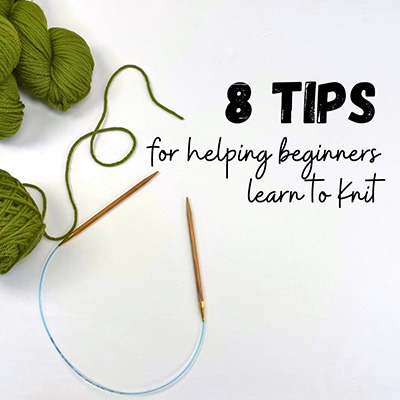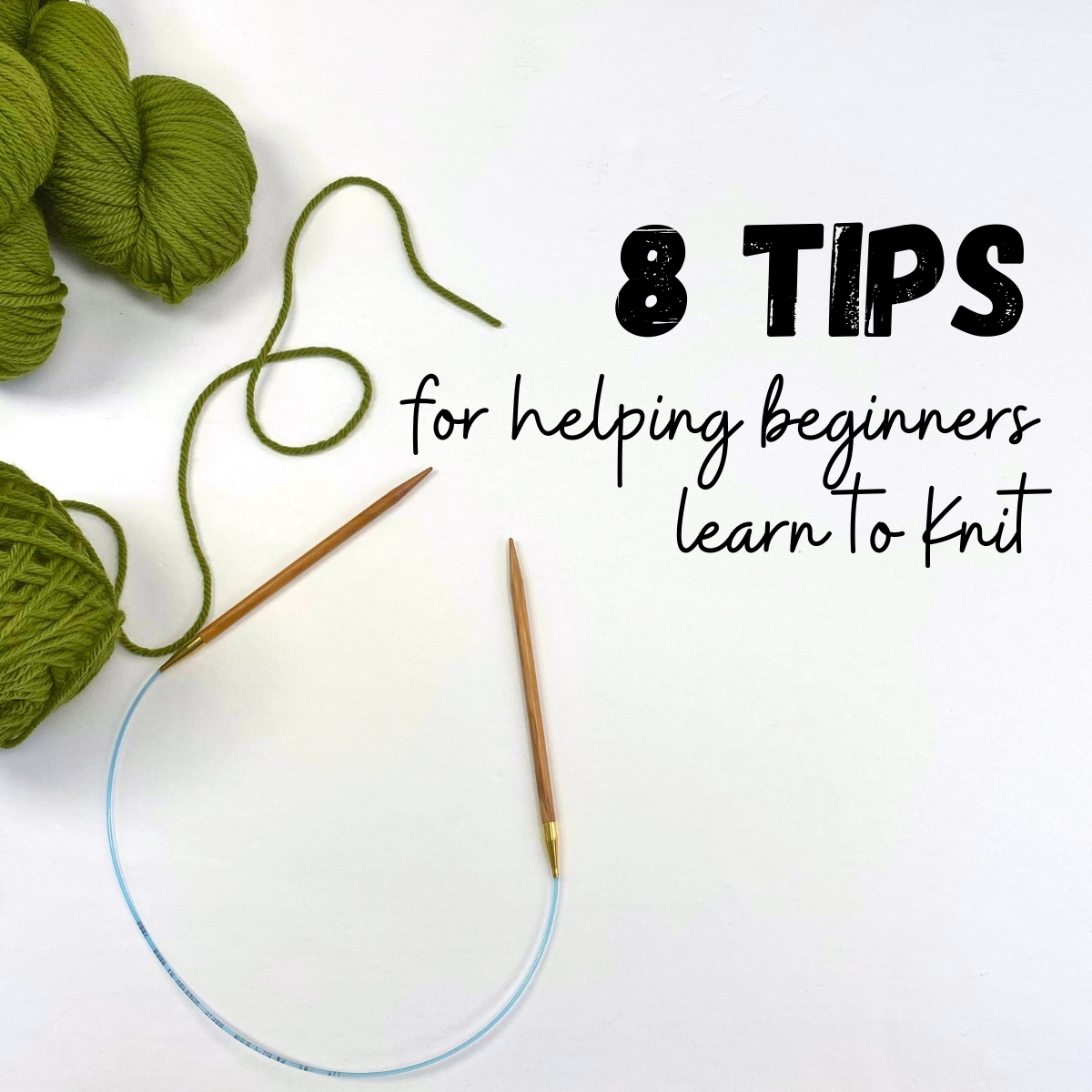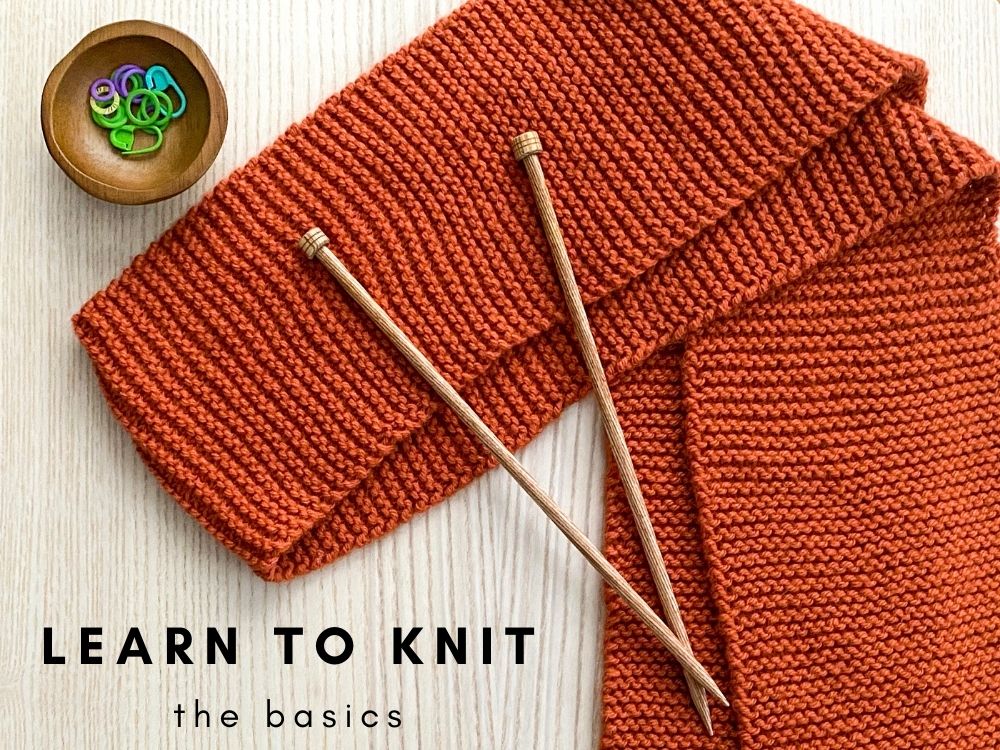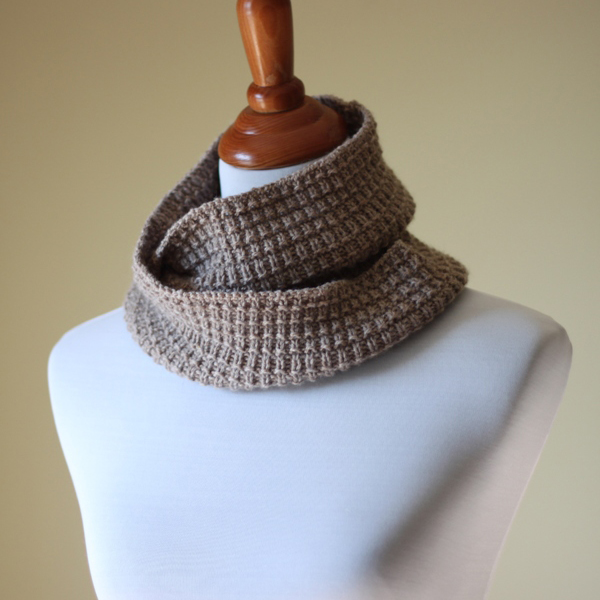Through the years I’ve taught many people of all ages how to knit, so I thought I’d outline some of my favorite teaching tips! Whether you’re thinking of teaching a friend or family member to knit or just wanting to refresh your own skills, sometimes it’s good to revisit the basics of knitting, so I’ve also provided links below to my Learn to Knit resource and tutorials. I hope you find some of these helpful!
Tip #1: Start with a garter stitch scarf
The most important thing when it comes to learning to knit is to get comfortable holding the needles and yarn and building up your ‘muscle memory’ for the basic knit stitch. What better way than on a simple garter stitch scarf! Garter stitch is when you knit every row, so the new knitter will just be repeating the knit stitch over and over again.
There’s no better way to get comfortable with the basic knit stitch maneuvers, turning the work and just feeling comfortable overall with knitting needles in your hands. Here’s an extra tip: if your student doesn’t want to knit the 60″ of a traditional length scarf, they can make it much shorter and simply seam the ends together to make a cowl/neckwarmer!
Tip #2: Cast-on for them (or teach the easy backward loop cast-on)
Typical casting-on (such as the long-tail cast-on method) isn’t that hard, BUT if you’re not even comfortable holding the needles and yarn yet, it can be more awkward. I have always preferred to teach people how to work the knit stitch first. And then once they are more comfortable and understand the knit stitch, then I teach them how to work the long tail cast-on. This seems to work well for most of my students – once they are comfortable with the knit stitch, casting-on comes much more naturally to them!
Alternatively, teaching the backward loop cast-on is another good option. It’s super simple to do and allows your new knitter to at least be familiar with some kind of cast-on should they want to get started without someone else casting-on for them. Plus the maneuvers used in this cast-on are used in my thumb-method of the long-tail cast-on, so it can serve as a good ‘first step’ in learning how to cast-on. I have a video lesson for the backward loop cast-on here, and for the long-tail cast-on (thumb-method) here.
Tip #3: Use a smooth, light/medium color yarn
As you’re learning to knit, it’s important to clearly see the stitches. Two things that can make stitches harder to see are:
- If the yarn is fluffy/hairy/textured (think mohair, alpaca or tweed);
- If the yarn is really dark (like navy or black)
I like to use wool or superwash blends when I teach – these tend to be smooth yarns that are beginner-friendly. I also steer away from cotton yarns – cotton has no elasticity to it and so they don’t make an ideal “first knit” yarn.
Tip #4: Use a medium or chunky weight yarn
My personal preference is to use a worsted-weight or chunky-weight yarn. They tend to be more comfortable holding in your hands at first and they work up fairly quickly too so the new knitter gets a bit more instant gratification.
I don’t like to use really thin yarn like a fingering-weight because a) it would take forever for the new knitter to see any progress and b) thin yarn can be a bit harder to get consistent tension on at first. I also don’t like to use super bulky yarn because then you would have to use really large needles which often feel a little uncomfortable/awkward to hold at first.
There are so many great yarn options you could go with, but here are just a few favorites of mine:
- Ewe Ewe Yarns Wooly Worsted
- Malabrigo Rios
- Berroco Ultra Wool or Ultra Wool Chunky
- Berroco Vintage or Vintage Chunky
Tip #5: Show them how to wind yarn that comes in a hank
Some of the yarns I mentioned above (such as Berroco Ultra Wool or Ewe Ewe Yarns Wooly Worsted) come in skeins that don’t need to be wound into cakes in order to knit with them. So these are ideal for true-blue beginners.
But other yarns like Berroco Vintage or Malabrigo Rios do have to be wound into cakes in order to work with them. So it’s an important to teach new knitters the difference between the 2 as well as show them the different options for winding yarn. I have a video lesson all about this topic (including how to wind yarn even without a ball winder) here.
Tip #6: You can use straight needles OR circulars for the first scarf project
Often traditional straight knitting needles (otherwise referred to as “single point knitting needles”) are used when teaching beginners. And I recommend using a 10″ length (I don’t recommend 14″ length – those can be too cumbersome when just working a scarf). But, you could also teach a new knitter using a 24″ circular needle and knitting back and forth (note: 16″ length is too short and 32″ would be too long – 24″ length is perfect). And this has become my go-to method for teaching.
The benefits of working on a circular back and forth is that it can be easier on the wrists. The downside is that many ‘learn to knit’ videos show working on a straight needle so that may be confusing for new knitters for the video to not match what they have in their hands. But if you are teaching someone side-by-side and they aren’t 100% relying on videos to learn, then teaching them on a circular would work just fine! Plus I do also have a video tutorial that shows how to work back and forth on a circular that they can refer to. In the past, often I will teach someone their first project on straight needles and then introduce circulars on their second project, so that’s another option to consider.
Tip #7: Use wooden needles rather than metal
Regardless of straight or circular, I highly recommend new knitters use wooden needles (like these) and not metal. Metal is often too slippery for new knitters and the last thing you want are stitches flying off the needles!
Tip #8: 20 Minutes a Day for 2 Weeks
When I worked at a yarn shop, we used to always tell new knitters that the key in the beginning is consistency. That’s how muscle memory gets formed (and if you want to understand the science of ‘muscle memory’, check out this interesting article). Even just 20 minutes a day for 2 weeks can be enough to get that muscle memory started. Some people may take to it quicker than others but even if learning to knit doesn’t seem to come easily for you, with practice anyone can do it! So it’s good to remind new knitters that for most people it takes time, and for their first project it’s best to focus on practice over perfection.
Other General “Learn to Knit” Notes….
English vs Continental knitting:
There are 2 different methods of knitting – “English” (where you hold the yarn in your right hand) or “Continental” (where you hold the yarn in your left hand). The English method tends to be more common, especially in ‘learn to knit’ videos or books (but it depends on where you live geographically). If you would like to learn more about the two methods and the pro’s and con’s of each, check out this article. In regards to my videos and tutorials, I always show everything using the English method.
What if you are teaching someone left-handed?
There are lots of different schools of thought regarding this. But one thing I was always taught is that knitting is very much a two-handed activity, so regardless of whether you are right-hand dominant or left-hand dominant, knitting teaches you to work with both of your hands. So left-hand knitters shouldn’t feel they have to learn a different way to knit (although if you Google the topic, you will find information about this if you are interested).
I will say though that many left-hand knitters have found they are more comfortable learning the Continental method of knitting instead of English. This is because in Continental knitting, you are holding the working yarn in your left hand instead of your right. So if you are left-handed and have had trouble with the English method, I highly recommend trying out the Continental method (here’s a video you can refer to from Noble Knits).
Knitting Basics: Pattern & Tutorials
If you would like to learn to knit, teach someone else to knit or just refresh your own basic knitting skills, check out my Learn to Knit page. This page has all the videos you will need to get started knitting. You can pair them with my “The Basics” pattern – this PDF has 3 basic ‘learn to knit’ patterns in it. The first pattern is the very basic Appleton, a garter stitch scarf. Then the second pattern is Bethel which introduces the purl stitch and is a rib scarf. Then the third pattern is Canaan which combines both knit and purl stitches and introduces working in the round to create a cowl.
I’ve written all three patterns for three different weights of yarn – you can use DK, Worsted or Bulky-weight. So your student (or yourself!) have lots of options.
I hope this information about teaching how to knit as well as my ‘learn to knit’ page is helpful as you share your love of knitting with others as well as refresh your own basic knitting skills. Feel free to reach out to me if you have any questions!






